So you want to build a basement suite? The City of Edmonton has amended bylaws in the past few years to make legal basement suites more well defined and safer and also gives Edmonton real estate investors more resources to know what to do. Unfortunately not everything is written down in one place and so I will try to make the steps toward choosing a place a little simpler. Some investors want to buy a home just to make into an up-down rental. How you do that is by following the guidelines. Now, it is in the best interest of the city to make sure that secondary suites are safe, but also, Edmonton recognizes that we should have higher density housing and this is an easy way to allow for that, without changing the character of older single-family home neighbourhoods. This seems like a win-win situation. Nothing changes from the outside, but there are more units for rent in Edmonton. There are other kinds of suites, but in this case, we will just deal with basement suites.
For clarity, Alberta Municipal Affairs and Housing defines a secondary suite as:

A second self-contained dwelling unit that is located within a primary dwelling unit, where both dwelling units are registered under the same land title. – Alberta Municipal Affairs and Housing Bulletin, April, 2007 (97-FCB-031)
Here is a checklist to make sure the subject property isn’t missing any obvious requirements:
| Item | Requirement | |
| Primary Considerations | ||
| Zoning | Zoning is acceptable for a secondary suite | |
| Detached home | The property is a single detached home (house) | |
| Other suites | Home doesn’t already have a secondary suite | |
| Lot size | The lot is large enough for a secondary suite | |
| Suite size | The home is large enough to have a suite | |
| Entryway | The property is built in such a way that a separate entrance is possible | |
| Ceiling height | The ceiling is high enough in the basement | |
| Parking* | An extra parking stall is possible on the site (extra stall needed). *Except where no extra parking stall is needed (in a rare number of locations). | |
| Secondary Considerations | ||
| Window sizes/type | The windows are large enough to meet egress | |
| Doorway sizes | The entryway doorway is large enough | |
| Doorway sizes (2) | Other doorway are large enough | |
| Shared Ceiling/Walls | The ceiling and any shared walls in the basement are drywalled (or will be) | |
| Heating/Ventilation | The basement will have separate heat control | |
| Smoke detectors | Smoke alarms are interconnected between the two suites |
Obviously, there is much work to do after you have found the correct property, but you need to start with a suitable home before you add a basement suite. Primary considerations are things that are not easy to change. Secondary considerations are changeable, but can be expensive.
Primary Considerations for Basement Suites
1 – Zoning
There is no point in looking at properties that do not have the correct zoning for a basement suite. This is because the zoning regulations on basement suites is actually quite lax. Any property with the zoning RF1, RF2, RF3, RF4, RSL and many other specific zonings will allow for a suite. So this is pretty simple. But it is still best to start here before going any farther. How do you find the zoning of a property? Check out the City of Edmonton Maps website and do a quick search for the property. Your real estate agent should be able to do this for you as well.
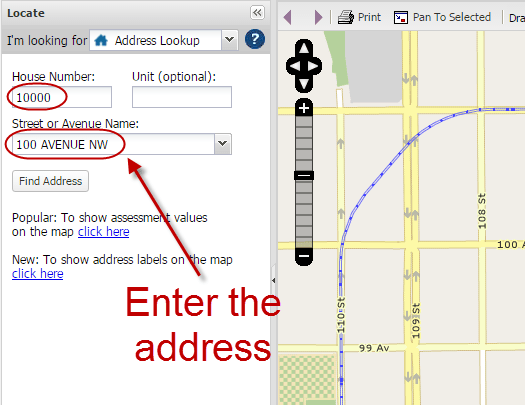
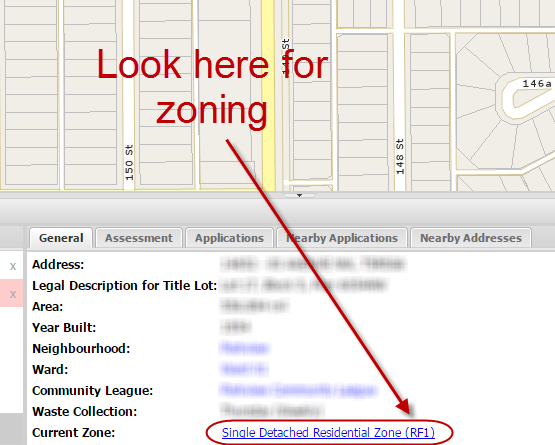
There you go. Now you have verified the zoning of the property. If it sits within the allowable types, you’re ok! There are some areas where this is not allowed – the City of Edmonton website has this in the secondary suites FAQ (check out this map for restricted areas):
Additional Restrictions apply to the following neighbourhoods:
Gold Bar, Maple Ridge, Beverley Heights, Rundle Heights, and a portion of Horse Hill rural subdivision. These locations are near the Edmonton-Strathcona boundary, where limitations apply within 1.5 km of Edmonton-Strathcona boundary due to heavy industrial areas.
2 – Detached Home
Is this property a single family dwelling? And is it a detached home? Basically, is the property in question a house? If it is, then you’re good to go. If it is not, then this isn’t the property for a basement suite, so move on to something else. What isn’t acceptable? Townhouses, duplexes, triplexes, apartment buildings, group homes and everything else. And you’ll need to actually have a basement and more than likely it will have to be the right type of basement. That is, you’ll likely need a full basement, not a partial basement – there just won’t be enough room otherwise.
3 – Other suites
This one is really easy. Does the home have a basement suite already? Or does it have a garden suite or garage suite? Then you can’t have another one. So unless the rules change, forget about this property for developing more suites. If you want to just buy a property with a secondary suite, then by all means, go for it. Legal basement suites are not too common, though, so building your own might still be desirable.
4- Lot Size
This one may affect quite a few properties in Edmonton. The lot size must be over 360m2. You can check the lot size at the City of Edmonton, as well. Enter the address just like before and check in the middle of the details instead.
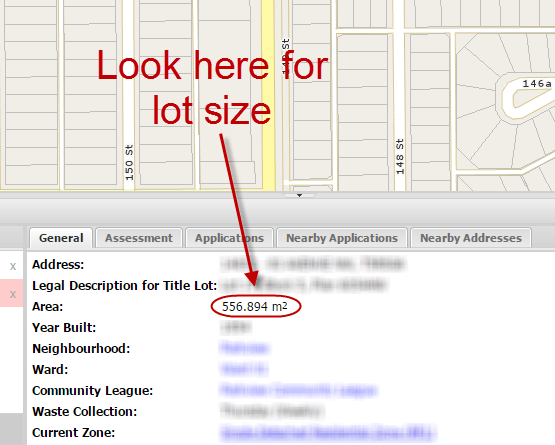
5 – Suite Size
This one shouldn’t be of a problem for any house.According to Zoning Bylaw 12800, the basement suite needs to be able to be larger than 30 m2 – 322.92 ft2, which is pretty small. All houses I know of are larger than this – so just be sure to give enough of the basement floor area to the suite. The basement suite also cannot be larger than the main floor – which is really unlikely anyhow. I don’t know of any basements that are larger than the main floor, anyhow, but someone could build a home like this and that is probably why the city has barred this format for suites.
6 – Entryway
This one is really important and will cut out many of the prospective properties quite quickly. You absolutely have to have a separate entrance for the basement suite. This is an entrance that will be blocked off from the upstairs unit. This is for fire safety and security. These are separate units, remember. So certain floor plans will not work, or will not easily work with basement suite layouts – for example, a lot of two-storey houses have a central staircase far away from an entrance and these layouts will not work.
Secondary Suites must have separate entryway that is at the side or rear of the Dwelling, or through a separate entrance within a common landing so as to appear as a Single Detached Dwelling. – Secondary Suites Summary Document, Table 4, Entryway Location – The City of Edmonton
Tip: If you are dedicating an entryway for one of the suites (up or down), you may be able to eliminate a staircase and use the area for the suites instead. This has a potential to increase floor space for laundry, utility, entryway, closet or even kitchen or living space for the units. Just be aware that if you ever want to revert back to a single unit home, this staircase will have to be rebuilt.
7 – Ceiling Height
This issue shouldn’t be too prevalent except in a few areas of town where the homes are older. Typically if a home is built in the mid-1950s, I have found that the basement ceiling height will likely be adequate. Alberta Building Code (2014) states that ceiling heights need to be at least 195 cm (6′ 5″) in general and be at a minimum (185 cm) 6′ 1″ high. This makes sense and shouldn’t be too hard to meet. Some bulkheads might be lower than 185 cm (6′ 1″), but it seems to be a rare occurrence. It’s not something I have seen in many homes.
2.17.2.1. Height of Rooms and Spaces
1) Unless acceptable to the authority having jurisdiction, the height of rooms or spaces in a secondary suite over the required minimum area in accordance with Table 9.5.3.1. of the Alberta Building Code 1997 shall be not less than 1.95 m.
– Alberta Municipal Affairs and Housing Bulletin, April, 2007 (97-FCB-031)
8 – Parking
This issue can kibosh some plans for basement suites because some home just don’t have the space for extra parking. A third parking stall is a requirement for a basement suite. Almost all driveways will allow for two parking stalls, but if someone is going to live in the basement, they are going to need a car and that means one more spot. Street parking does not count, although I am sure it would be valued. Look for properties with wide enough lots to pour additional parking stalls next to the driveway. Tandem parking stalls are allowed as stated in this summary document under Table 3. I have no other reference to the width of a parking stall, but it is defined here under the landscaping guidelines as needing to be 3.1 meters wide:
Driveways must be at least 3.1 metres wide and have a maximum width of 3.1 metres per side-by-side parking stall. – Landscaping Regulations – The City of Edmonton
I would check with Planning and Development if you are unsure whether your property can accommodate a parking stall this wide or not. I can find no guideline for parking stall length, but my feeling is that about 5.5 metres to 6.1 metres (18 to 20 feet) is reasonable. That is a general minimum for garages, so it stands to reason it would be for parking stalls as well. Again, check with the City to verify length requirements.
*Parking can be ‘0’ extra spaces for secondary suites that are located in specific areas of the city. This will not be helpful for most properties, but it’s worth checking out. The document that defines this is here.
Secondary Considerations for Basement Suites
Secondary considerations for basement suites are things that should be changeable for most places, so they are not likely deal killers if they are not already in place. These are things that you will likely have to add or change when you decide to develop a suite. This may not be everything you need to do, so plan carefully and talk to the City Planning Department if you are unsure of how to proceed.
9 – Window Size/Type
All basement bedrooms need appropriate window types and sizes and basement suites are no exception. You want your tenants to be able to get out in case of a fire. These requirements are listed in the Building Code and need to be followed. Here is a bulletin on the subject.
10 – Doorway sizes
It is possible for any of these secondary considerations to be very expensive to fix, so before buying a property, check on the door sizes into the unit and within the unit. The Entry doorway needs to be 6′ 10″ high. Other doors in the unit need to be at least 6′ 5″. The reasoning behind this apparently is for fire code. Doorway widths are supposed to be 81 cm (32 inches) for exit doors according to Alberta Building Code. You should make all doors this wide in your basement suite. Hallways have the same requirement, so make sure you don’t go building any walls that make for too-narrow hallways.
11 – Shared Ceiling & Walls
Walls and ceilings that are shared between the two units need to be drywalled (for fire safety) with at least 1/2″ drywall.
12 – Heating & Ventilation
Heating systems in new basement suited need to be separate. The basement suite needs its own furnace or heater and ventilation cannot be mixed between the units. This makes sense for fire safety – smoke in the case of a fire will not travel between units – also this makes sense for quality of life for the tenants – cooking smells and cigarette smoke will not travel between the units. These spaces are supposed to be entirely separate and interconnected ducting does not allow for separate units.
13 – Smoke & Carbon Monoxide Detectors
Smoke and carbon monoxide detectors need to b interconnected between the two units for fire and CO safety. This makes sense. If the basement has a fire, the people upstairs need to know about it. Interconnected alarms are common now especially if they are hardwired, but you can get alarms that will talk to each other through a wireless signal even if they are not hardwired alarms.
So there you have it. The general guidelines to finding the right house for a basement suite. This is not an exhaustive list – there are other considerations for developing a basement in general and these need to be followed for suites as well. Before you start any work on your project, you need to make an application to the City with the appropriate information. Make sure to get the appropriate permits before starting any construction project. For extra information, here is a brochure from the Safety Codes council on finishing your basement.
If you have any information or questions about basement suites in Edmonton, please let me know!
by +Alan F Macdonald REALTOR® | Copyright © – gimme-shelter.com
[30007]
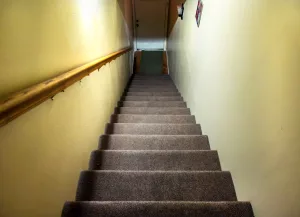
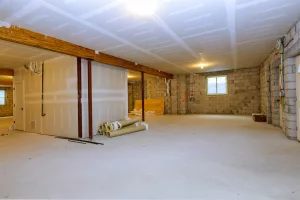
Hey Alan, I really like your article . My name is Nilam. Me and my husband Ruchin are looking for the Bi-level single detached house which has potential to make legal basement suite. Please, let us know that if you could help us in our property search.